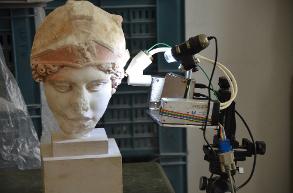"PolyCRomA" - The meaning of colour in Roman Africa
In November 2020, Dr Elisabetta Neri, a post-doctoral fellow at the atomic and nuclear spectroscopy laboratory at the University of Liège, was awarded a European MSCA Individual Fellowship for a period of two years, in order to study the significance of the polychromy of Roman imperial statues (1st-4th century AD), on an unprecedented scale.
The project, named “PolyCRomA”, proposes the first systematic study of the use of colour in the statuary of an important Roman province, and will consider 20 statues from the collections of the Bardo museum in Tunisia. The variety of typologies, qualities and provenances (local, Asia Minor, Rome) of the statues in this corpus holds up a mirror to African society of the period. Moreover, as the archaeological context of discovery is well known, the meaning of the polychromy will be analysed in relation with the socio-political and religious purpose with which these artefacts were conceived. The preserved traces of colour will first be documented by coupling visual investigation (with the support of multispectral imaging and UV and VIL videomicroscope) and in-situ analyses (XRF and μRaman) in order to identify the techniques used to colour the statues. Selected micro-samples will undergo further quantitative analyses (PIXE, SEM/EDX, hyperspectral imaging, FT-IR). Finally, literary and epigraphic sources of Proconsular Africa mentioning the colour of statues will be inventoried and the use of colour on the statues will be compared with their counterparts in painting and mosaic.
To follow the project and learn more about the team and the institutions involved, see:
https://www.polychroma.uliege.be/cms/c_6264927/en/polychroma
Added: 08/04/2021
